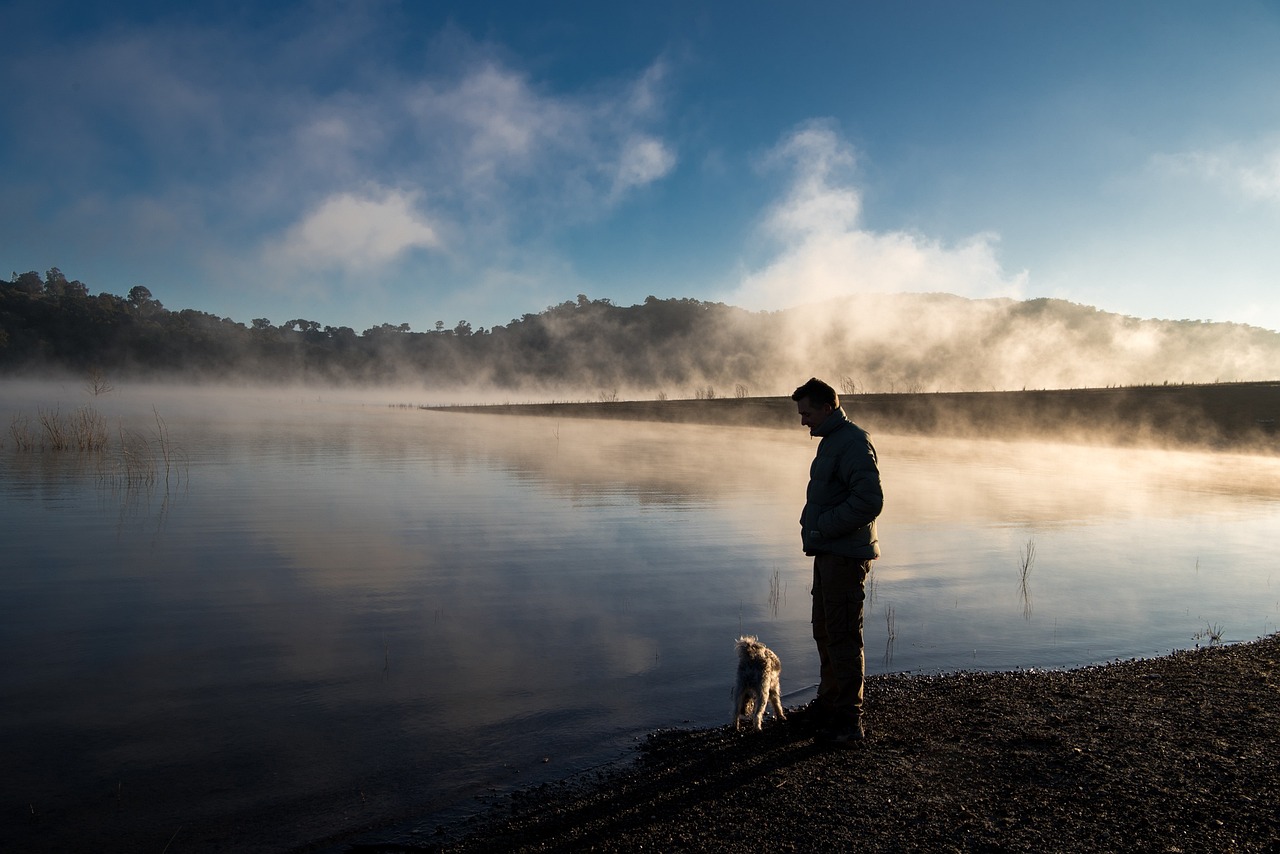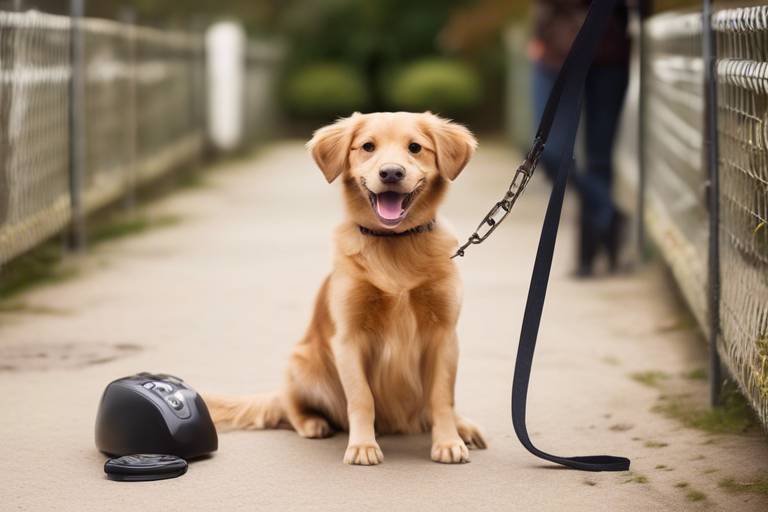How to Help Your Dog Overcome a Fear of Water
Does your furry friend cringe at the sight of water? You're not alone! Many dogs experience a fear of water that can be puzzling and concerning for their owners. Understanding how to help your dog overcome this fear not only enhances their quality of life but also allows for more enjoyable outdoor adventures together. By employing effective strategies, pet owners can transform their dog's perception of water from one of fear to one of fun and excitement. So, let's dive into some practical tips and techniques to help your canine companion conquer their aquatic anxieties!
Before we tackle the solutions, it's crucial to understand why your dog might be afraid of water in the first place. Canine fear of water can stem from various factors, including:
- Past Traumatic Experiences: Perhaps your dog had a negative encounter with water, such as falling into a pool or being sprayed by a hose. These experiences can leave lasting impressions.
- Genetics: Some breeds are naturally more cautious or less inclined to enjoy water, which can contribute to their fear.
- Lack of Exposure: If your dog hasn't been exposed to water environments during their critical developmental stages, they may not know how to react when they encounter water later in life.
Recognizing the signs of fear in your dog is crucial for addressing their anxiety effectively. Common behaviors that indicate your dog is afraid of water include:
- Trembling: Shaking can be a clear sign of fear and stress.
- Hiding: If your dog seeks refuge away from water sources, it’s a strong indicator of their discomfort.
- Whining: Vocalizations often accompany fear; listen closely to your dog's sounds.
- Attempting to Escape: If your dog tries to flee when near water, it’s time to take action.
Specific behavioral cues can reveal your dog's discomfort around water. Observing these signs closely can help you tailor your approach to desensitize your pet effectively. For instance, understanding your dog's body language can provide insight into their emotional state. Signs like lowered ears or a tucked tail often indicate fear or anxiety. Additionally, vocal cues such as barking or whining should not be ignored, as they can signal your dog's stress levels.
Understanding your dog's body language is essential. When near water, if you notice their ears pinned back, tail tucked, or a stiff posture, these are clear signs they are feeling uneasy. These behaviors can guide your training methods, allowing you to approach the situation more sensitively.
Listening for vocal cues is equally important. If your dog is barking excessively or whining when they see water, it indicates a level of fear that needs to be addressed. These sounds often reflect stress and should be taken seriously during training sessions.
Physical symptoms, such as panting or pacing, can also indicate fear. Recognizing these reactions allows you to intervene and create a more positive experience for your dog. For example, if you notice your dog pacing back and forth or breathing heavily, it may be best to remove them from the situation and try again later.
Implementing gradual exposure techniques can help desensitize your dog to water. Start with small steps and gradually increase their exposure, ensuring a comfortable and positive experience throughout the process. Begin with shallow water, allowing your dog to explore at their own pace. This method builds confidence without overwhelming them in deeper waters.
Introducing your dog to shallow water can ease their fears. Consider taking them to a calm stream or a shallow kiddie pool. Allow them to explore this new environment at their own pace, rewarding them with treats and praise for any brave steps they take. This approach helps to create a positive association with water, making it less intimidating.
Using treats and praise during water exposure can create positive associations. Whenever your dog approaches water, shower them with affection and rewards. This method encourages your dog to view water as a safe and enjoyable environment, transforming their fear into curiosity and excitement.
When fear persists despite your best efforts, seeking help from a professional dog trainer or behaviorist can be beneficial. These experts can provide tailored strategies and support for overcoming water-related fears effectively. They often have experience dealing with similar situations and can offer insights that may not be immediately obvious to pet owners.
Q: How long does it take for a dog to overcome their fear of water?
A: The time it takes varies by dog. Some may overcome their fear in a few sessions, while others may take weeks or months. Patience is key!
Q: Can all dogs learn to enjoy water?
A: While many dogs can learn to enjoy water, some breeds may always be more cautious. It’s important to respect your dog's individual personality.
Q: Is it safe to force my dog into the water?
A: Forcing a dog into water can reinforce their fear. Always use positive reinforcement and gradual exposure instead.

Understanding Canine Fear of Water
Understanding why your dog may be afraid of water is the first step in helping them conquer this fear. Just like humans, dogs can have their own unique experiences that shape their feelings towards certain things. One of the primary reasons for a dog's fear of water could be past traumatic experiences. Perhaps they had a negative encounter with water, such as being unexpectedly splashed or falling into a pool, which left a lasting impression on their young minds. Imagine how you would feel if you had a similar experience—it's no wonder that some dogs develop a fear that lingers long after the incident.
Another factor to consider is genetics. Some breeds are naturally more cautious or anxious than others. For instance, a breed known for its love of water, like a Labrador Retriever, might still have individual dogs that are wary of it due to their unique personality traits. Additionally, a dog's early life experiences, or lack thereof, can play a significant role. If a puppy is not exposed to water at a young age, they may grow up with an inherent fear simply because they are unfamiliar with it. Just think about how you might feel if you were suddenly dropped into a new environment without any prior knowledge—confusion and fear would likely set in!
Moreover, the environment in which a dog is raised can contribute to their fear of water. If they have not been socialized properly or if they have witnessed other animals or people reacting negatively to water, they may adopt that same fear. In this case, it's essential to recognize that their fear is not just a quirk but a genuine emotional response that needs to be addressed with care and patience.
By understanding these factors, you can better tailor your approach to helping your dog. Remember, it’s not just about getting them wet; it’s about creating a positive and safe experience that gradually helps them associate water with fun and enjoyment. In the following sections, we will explore the signs of fear in dogs, so you can identify if your furry friend is struggling with water anxiety.

Signs Your Dog is Afraid of Water
Understanding the signs that your dog is afraid of water is crucial for any pet owner. Dogs, much like humans, can experience anxiety and fear, and recognizing these emotions is the first step towards helping them. You might notice your furry friend displaying certain behaviors that indicate their discomfort. For instance, if your dog is trembling or hiding away whenever water is nearby, it’s a clear signal that they are feeling anxious. But why do some dogs react this way? It could stem from past traumatic experiences, a lack of exposure to water, or even genetic predispositions. Observing these signs closely can help you tailor your approach to desensitize your pet effectively.
Common behaviors that suggest your dog is afraid of water include:
- Trembling: A classic sign of fear that can be quite noticeable.
- Hiding: Your dog might seek refuge in a corner or behind you when water is present.
- Whining or Barking: Vocalizations can indicate stress and discomfort.
- Attempting to Escape: If your dog tries to flee when near water, it’s a strong indicator of fear.
Additionally, it’s essential to pay attention to your dog’s body language. A dog that is afraid of water may exhibit signs such as:
- Lowered Ears: Ears that are pinned back can signal fear or anxiety.
- Tucked Tail: A tail that is tucked between the legs often indicates submission or fear.
- Wide Eyes: If your dog's eyes are wide and darting, they might be on high alert.
Listening to your dog's vocalizations can also provide insight into their emotional state. If you hear them barking or whining excessively when near water, it’s important to take these sounds seriously. They often indicate a high level of stress and should be addressed promptly during your training sessions. Moreover, physical reactions such as panting or pacing around can be additional signs that your dog is feeling uneasy. Recognizing these reactions allows you to intervene and create a more positive experience for your dog.
Remember, every dog is unique, and their responses to water may vary. By being observant and understanding their signs of fear, you can take the necessary steps to help your dog overcome their anxiety. In doing so, you not only enhance their quality of life but also strengthen the bond between you and your furry companion.
- What should I do if my dog refuses to go near water?
Start with gradual exposure and use positive reinforcement to encourage them. - Can I force my dog to swim?
Forcing a dog into water can increase their fear. It's better to let them approach water at their own pace. - How long does it take for a dog to get used to water?
Every dog is different; some may take a few sessions, while others might need weeks of gentle exposure. - Should I consult a professional trainer?
If your dog’s fear persists, seeking help from a professional can provide tailored strategies for overcoming their anxiety.
Behavioral Indicators
When it comes to understanding your dog's fear of water, paying close attention to their is crucial. Dogs, much like humans, express their emotions through various behaviors. If you notice your furry friend acting differently around water, it might be a sign that something is amiss. For instance, if your dog is trembling or hiding when they see a pool or even a puddle, it’s a clear indication of anxiety. These behaviors can stem from a variety of sources, including past negative experiences or simply a lack of exposure to water. By observing these signs, you can tailor your approach to help them overcome their fear.
One of the most telling signs of discomfort is body language. Dogs communicate a lot through their posture and movements. If your dog has lowered ears, a tucked tail, or seems to be avoiding eye contact, they are likely feeling stressed. These subtle cues can guide you in understanding how to proceed with training. For example, if you notice these signs, it might be best to take a step back and allow your dog to acclimate to their environment at their own pace.
Additionally, vocalizations can be another indicator of fear. If your dog is barking excessively or whining when near water, these vocal cues often reflect their internal state of distress. It’s essential to take these sounds seriously, as they are your dog’s way of expressing that they are uncomfortable. Listening to your dog’s vocalizations can help you gauge their fear levels and adjust your training techniques accordingly.
Furthermore, physical reactions such as panting, pacing, or even attempts to escape can be significant indicators of fear. If your dog exhibits these behaviors, it’s a clear signal that they are not ready to face their fear just yet. Recognizing these reactions allows you to intervene and create a more positive experience for your dog. You might consider taking a break from water activities and engaging in other fun activities that your dog enjoys to help alleviate their stress.
In summary, being vigilant about your dog’s behavioral indicators is key to understanding their fear of water. By closely observing their body language, vocalizations, and physical reactions, you can create a supportive environment that encourages them to gradually overcome their fears. Remember, patience is vital in this process, and every little step counts!
- How long does it take for a dog to overcome their fear of water? The time it takes varies significantly from dog to dog, depending on their individual temperament and past experiences. Some dogs may take a few weeks, while others might need several months.
- Can all dogs learn to enjoy water? Most dogs can learn to be comfortable around water, especially with gradual exposure and positive reinforcement. However, some dogs may never fully embrace it due to deep-rooted fears.
- What should I do if my dog is showing extreme fear? If your dog exhibits severe fear responses, it might be best to consult with a professional dog trainer or behaviorist who can provide specialized guidance.
- Is it safe to force my dog into the water? No, forcing your dog into the water can increase their fear and anxiety. It’s essential to allow them to explore at their own pace.
Body Language
This article provides insights and strategies to assist pet owners in helping their dogs conquer their fear of water, ensuring a safer and more enjoyable experience for both dog and owner.
Exploring the reasons behind a dog's fear of water can help owners address the issue effectively. Factors may include past traumatic experiences, genetics, or lack of exposure to water environments.
Recognizing signs of fear in your dog is crucial. Common behaviors include trembling, hiding, whining, or attempting to escape when near water, which indicate anxiety that needs to be addressed.
Specific behavioral cues can reveal your dog's discomfort around water. Observing these signs closely can help owners tailor their approach to desensitize their pets effectively.
Understanding your dog's body language is essential in determining their comfort level around water. Dogs communicate a lot through their physical posture and movements, and recognizing these cues can be a game changer for your training efforts. For instance, if your dog approaches the water with lowered ears and a tucked tail, it’s a clear indication that they are feeling anxious or scared. On the other hand, a dog that is relaxed might have their ears perked up, tail wagging, and a playful demeanor.
Here are some key body language signs to watch for:
- Tail Position: A tail that is held low or tucked between the legs suggests fear, while a wagging tail can indicate excitement or curiosity.
- Ears: Ears that are pinned back against the head often signify stress or fear, whereas ears that are upright and alert show interest.
- Posture: A dog that is cowering or backing away from water is clearly uncomfortable. In contrast, a dog that approaches with a relaxed stance is more confident.
By paying close attention to these signals, you can adapt your training methods accordingly. If your dog shows signs of distress, it might be wise to take a step back and allow them to acclimate to the environment at their own pace. Remember, patience is key! Just like us, dogs need time to process new experiences, especially when they are associated with fear.
Listening for vocal cues, like barking or whining, can help identify your dog's fear levels. These sounds often indicate stress and should be taken seriously during training.
Physical symptoms such as panting or pacing can indicate fear. Recognizing these reactions allows owners to intervene and create a more positive experience for their dogs.
Implementing gradual exposure techniques can help desensitize your dog to water. Start with small steps and gradually increase their exposure, ensuring a comfortable and positive experience throughout the process.
Introducing your dog to shallow water can ease their fears. Allow them to explore at their own pace, building confidence without overwhelming them in deeper waters.
Using treats and praise during water exposure can create positive associations. This method encourages your dog to view water as a safe and enjoyable environment.
When fear persists, seeking help from a professional dog trainer or behaviorist can be beneficial. These experts can provide tailored strategies and support for overcoming water-related fears effectively.
- Q: How long will it take for my dog to overcome their fear of water?
A: The duration varies by dog. Some may adapt quickly, while others might take weeks or even months. Patience is essential! - Q: Should I force my dog into the water?
A: Absolutely not! Forcing your dog can worsen their fear. Always allow them to approach water on their own terms. - Q: Can all dogs learn to love water?
A: While many dogs can learn to enjoy water, some may always have a natural aversion. It's important to respect their comfort levels.
Vocalizations
When it comes to understanding your dog's fear of water, vocalizations play a crucial role. Dogs communicate their feelings through a variety of sounds, and being attentive to these vocal cues can provide valuable insight into their emotional state. For instance, if your dog is barking excessively or whining when near water, it’s a clear indication that they are feeling anxious or scared. These vocalizations are not just random noises; they are your dog's way of expressing distress. Imagine being in a situation that terrifies you and not being able to voice your fears—your dog is doing just that!
It’s essential to take these sounds seriously. Ignoring them can lead to increased anxiety and reinforce their fear of water. Instead, consider these vocalizations as a form of communication that requires your attention. For example, if your dog begins to whine while approaching a pool or lake, it’s a signal that they need support and reassurance. In such moments, responding with a calm voice and gentle encouragement can make a world of difference.
To help you better understand the various vocalizations your dog may exhibit, here’s a brief overview:
| Vocalization | Possible Meaning |
|---|---|
| Barking | Alertness or fear; may indicate a strong reaction to water |
| Whining | Distress or anxiety; often a plea for help or comfort |
| Growling | Defensive behavior; may indicate fear or discomfort |
| Panting | Stress or excitement; can indicate a need to calm down |
By paying attention to these vocal cues, you can tailor your approach when introducing your dog to water. For instance, if your dog is barking in fear, it might be beneficial to take a step back and reassess the situation. Perhaps you need to create a more comfortable environment or provide more positive reinforcement. Remember, your goal is to help your dog associate water with positive experiences, and understanding their vocalizations is a key part of that process.
- What should I do if my dog refuses to go near water?
Start with gradual exposure, allowing them to explore at their own pace. Use treats and praise to encourage positive associations. - How long will it take for my dog to overcome their fear of water?
It varies by dog; some may take weeks, while others might need months. Patience and consistency are crucial. - Can I help my dog overcome their fear of water on my own?
Yes, many owners successfully help their dogs with patience and positive reinforcement, but don’t hesitate to seek professional help if needed.
Physical Reactions
When it comes to understanding your dog's fear of water, can be some of the most telling signs. Dogs, much like humans, experience a range of emotions, and their bodies often betray their feelings before they can express them vocally. For instance, if your dog starts to pant heavily or paces back and forth when near water, these are clear indicators of anxiety. It's like when we feel nervous before a big presentation; our bodies react even if we try to stay calm.
Moreover, dogs may exhibit other physical symptoms that indicate fear. Some common reactions include:
- Trembling: This can happen when a dog feels scared or threatened, making them appear as if they are shivering.
- Excessive drooling: Just like humans can sweat when anxious, dogs may drool more than usual when they are scared.
- Trying to escape: If your dog is attempting to flee the area, it’s a clear sign that they are uncomfortable.
Understanding these physical cues is crucial for you as a pet owner. They not only provide insight into your dog's emotional state but also help you decide on the best course of action to alleviate their fears. For example, if you notice your dog trembling at the sight of water, it might be wise to take a step back and reassess the situation. Instead of forcing them into the water, consider creating a more comfortable environment where they can gradually acclimate to the idea of being near it.
Additionally, it's essential to monitor your dog's behavior continuously. If you observe that their fear escalates—perhaps they start to hide or bark excessively—this is a signal to pause and regroup. You can try to create a calming atmosphere by using soothing voices or even playing their favorite games away from the water. Remember, patience is key! Just like building trust in any relationship, helping your dog feel safe around water will take time and understanding.
Q: What should I do if my dog refuses to enter the water?
A: If your dog is adamant about not entering the water, it's essential to respect their boundaries. Try to engage them in water-related activities from a distance, gradually bringing them closer at their own pace. Positive reinforcement, like treats or praise, can also help.
Q: How long will it take for my dog to overcome their fear of water?
A: The duration varies from dog to dog. Some may take weeks, while others might take months to feel comfortable. It's crucial to be patient and allow them to progress at their own speed.
Q: Should I seek professional help if my dog’s fear seems severe?
A: Absolutely! If your dog's fear of water is severe and doesn't improve with your efforts, consulting a professional dog trainer or behaviorist can provide specialized strategies tailored to your dog's needs.

Gradual Exposure Techniques
When it comes to helping your dog overcome their fear of water, can be a game changer. The goal here is to introduce your furry friend to water in a way that feels safe and non-threatening. Think of it like teaching a child to swim; you wouldn’t throw them into the deep end right away, right? Instead, you’d start in shallow water, allowing them to get comfortable at their own pace. The same principle applies to our canine companions.
Start by finding a calm, shallow area where your dog can wade in without feeling overwhelmed. This could be a kiddie pool in your backyard or a gentle stream. The key is to ensure that the environment is quiet and free from distractions. Allow your dog to explore the area on their own terms. Let them dip their paws in, splash around, and sniff the water. This process is all about building confidence—the more positive experiences your dog has, the more likely they are to overcome their fear.
As your dog becomes more comfortable in shallow water, you can gradually increase the depth. However, it's crucial to move at a pace that suits your dog’s comfort level. If they seem hesitant, take a step back and allow them to acclimate again. This is where patience comes into play. You might find it helpful to keep a training journal to track your dog's progress. Documenting their reactions can give you insights into what works and what doesn’t.
| Step | Description | Tips |
|---|---|---|
| 1 | Introduce shallow water | Let your dog explore freely. |
| 2 | Gradually increase water depth | Move slowly; watch for signs of anxiety. |
| 3 | Use positive reinforcement | Reward with treats and praise. |
| 4 | Practice regularly | Frequent exposure helps build confidence. |
Incorporating positive reinforcement during these sessions is essential. Always have some treats handy and shower your dog with praise whenever they exhibit calm behavior around water. This will not only help them associate water with good things but also strengthen your bond. Remember, your energy plays a significant role in how your dog perceives the situation. If you're calm and relaxed, your dog is more likely to feel the same way.
Lastly, don't forget to celebrate small victories! Did your dog take a step into the water? That’s fantastic! Acknowledge it with excitement. These little moments of success will motivate your dog to continue exploring. With time, patience, and the right approach, your dog can learn to love water just as much as you do.
- How long will it take for my dog to overcome their fear of water? - Every dog is different. Some may take a few sessions, while others might need weeks or even months. The key is to be patient and consistent.
- Should I force my dog into the water? - Absolutely not! Forcing your dog can increase their fear. Always allow them to approach water at their own pace.
- What if my dog never likes water? - While many dogs can learn to enjoy water, some may always prefer to stay dry. Respect their preferences and find alternative ways for them to enjoy outdoor activities.
Starting with Shallow Water
When it comes to helping your furry friend conquer their fear of water, is a game changer. Imagine being tossed into the deep end of a pool without knowing how to swim; that’s how your dog feels when faced with a large body of water. By beginning with shallow water, you provide a safe and controlled environment that allows your dog to explore at their own pace. This gradual introduction is crucial to building their confidence and comfort level.
Begin by finding a calm and quiet spot, like a shallow stream or a kiddie pool filled with just a few inches of water. The key is to make this experience as stress-free as possible. You might want to bring along some of your dog’s favorite toys or even a few tasty treats to create positive associations with the water. Imagine how much easier it would be for your dog to dip their paws in if they know there’s a reward waiting for them!
As your dog approaches the water, allow them to sniff around and get accustomed to the new environment. Patience is vital here. If they seem hesitant, don’t force them in; instead, encourage them gently. Use a cheerful tone and maybe even splash a little water yourself to show them it’s all in good fun. You can even take a seat beside the water and toss a toy just a few feet away to spark their interest.
Once your dog is comfortable standing near the water, you can encourage them to take a step in. If they do, shower them with praise and maybe a treat or two. This positive reinforcement will help them associate the water with good feelings. Remember, the goal is to make this experience enjoyable, so keep the sessions short and sweet. If your dog starts to show signs of anxiety—like panting or trying to back away—take a step back and allow them to regroup.
To track your dog’s progress, you might consider keeping a simple table to note their reactions and achievements. Here’s a quick example:
| Date | Water Depth | Dog’s Reaction | Rewards Given |
|---|---|---|---|
| Day 1 | 1 inch | Curious, no hesitation | Treats and praise |
| Day 2 | 2 inches | Stepped in, wagging tail | Toys and treats |
| Day 3 | 3 inches | Jumped in excitedly | Lots of praise! |
By keeping track of these details, you can see how far your dog has come and adjust your training methods accordingly. Remember, every dog is different, and what works for one may not work for another. The important thing is to celebrate the small victories along the way!
In summary, starting with shallow water is a fantastic way to ease your dog into the world of water. With patience, positive reinforcement, and a little creativity, you can help your dog overcome their fear and maybe even learn to love splashing around. So, grab that kiddie pool and get ready for some fun!
- How long should I spend in shallow water with my dog? It's best to keep sessions short, around 10-15 minutes, to prevent overwhelming your dog.
- What if my dog refuses to go near the water? Take a step back and try again later. Use treats and toys to encourage them without forcing the situation.
- Can all dogs learn to enjoy water? While many dogs can learn to enjoy water, some may always prefer to stay dry. Respect their preferences!
Incorporating Positive Reinforcement
When it comes to helping your dog overcome a fear of water, positive reinforcement can be your best ally. Just imagine this: you’re at the beach, and instead of your dog cowering in fear, they’re splashing around joyfully. Sounds great, right? The key to achieving this transformation lies in how you approach the situation. Positive reinforcement involves rewarding your dog for exhibiting desired behaviors, which can significantly alter their perception of water.
Start by introducing your dog to water in a calm and controlled environment. This could be a kiddie pool or a shallow stream. As your dog approaches the water, use treats or their favorite toys to encourage them. The goal is to create a positive association with water. For instance, every time your dog takes a step closer to the water, reward them with a treat and lots of praise. You might say, “Good job!” or “What a brave pup!” This kind of encouragement can work wonders.
Moreover, consistency is crucial. Make it a habit to reward your dog whenever they show curiosity or bravery around water. Over time, they will start to associate water with positive experiences. To make this process even more effective, consider using a
| Date | Behavior Observed | Treats Given | Notes |
|---|---|---|---|
| 01/01/2024 | Approached shallow water | 2 | Very curious, wagging tail |
| 01/02/2024 | Entered shallow water | 3 | Played with a toy in the water |
| 01/03/2024 | Jumped into deeper water | 5 | Super excited, splashing around! |
As you can see, keeping track of your dog's progress not only helps you stay organized but also allows you to see how far they’ve come. Celebrate the small victories! Each step forward is a reason to cheer, and your dog will pick up on your enthusiasm.
Another effective strategy is to incorporate playtime into your water exposure sessions. Bring along a favorite toy that floats, and engage your dog in some fun games that involve water. This could be fetching a ball or playing tug-of-war with a water-resistant toy. The more enjoyable these experiences are, the more likely your dog will begin to see water as a place of fun rather than fear.
In summary, incorporating positive reinforcement into your training routine is essential for helping your dog overcome their fear of water. By rewarding bravery, tracking progress, and making water fun, you’ll be well on your way to creating a confident and happy water-loving pup. Remember, patience is key; every dog learns at their own pace, and your support will make all the difference.
- How long will it take for my dog to overcome their fear of water? Every dog is different, so the timeline can vary. Some may adapt quickly, while others might need more time and patience.
- Can I use negative reinforcement to help my dog? It's generally not recommended. Negative reinforcement can increase fear and anxiety, making the problem worse.
- What if my dog refuses to come near water? Take a step back and try to create a more positive environment. Gradually reintroduce water in a way that feels safe for them.
- Should I seek professional help? If your dog’s fear is severe, consulting a professional trainer or behaviorist can provide tailored strategies to help.

Professional Assistance
When your dog's fear of water seems insurmountable, it's time to consider . Just like humans sometimes need a little help from a therapist, our furry friends can benefit from the expertise of a trained dog behaviorist or professional trainer. These experts are equipped with the knowledge and experience to tackle complex behavioral issues, including fear of water. They can provide tailored strategies that are specifically designed to meet your dog's unique needs.
One of the first steps a professional might take is to conduct an assessment of your dog’s behavior. This involves observing your dog's reactions to water and identifying specific triggers that cause anxiety. By understanding the root of the problem, they can develop a customized training plan that may include gradual exposure techniques, positive reinforcement strategies, and even relaxation exercises. This approach not only helps your dog feel more comfortable around water but also strengthens the bond between you and your pet.
Moreover, professionals often utilize a variety of training tools and techniques that you might not be familiar with. For example, they may introduce your dog to water through games or interactive toys that engage their natural instincts. This playful method can make water seem less intimidating and more like a fun adventure. In addition, professionals can help you learn how to read your dog’s body language and vocalizations, enabling you to respond appropriately and effectively during training sessions.
Investing in professional help can also save you time and frustration. Instead of experimenting with different methods that may or may not work, a professional can guide you through the process, ensuring that you and your dog are making progress. They can also provide valuable support and encouragement, reminding you that overcoming fears is a journey that takes patience and persistence.
In summary, if your dog's fear of water is proving challenging to overcome, reaching out to a professional can be a game-changer. They offer expertise, tailored strategies, and ongoing support that can help transform your dog's relationship with water from one of fear to one of joy. Remember, every dog is unique, and with the right guidance, your furry friend can learn to embrace the splashes and fun that water brings.
- How do I know if my dog needs professional help? If your dog exhibits extreme fear or anxiety around water that doesn't improve with gradual exposure techniques, it may be time to consult a professional.
- What should I look for in a dog trainer or behaviorist? Look for someone who specializes in fear-based behaviors, has positive reviews, and uses humane training methods.
- How long does it take for a dog to overcome a fear of water? The timeline varies for each dog, but with consistent training and support, many dogs show improvement within weeks to months.
- Can I train my dog to like water on my own? Yes, many owners successfully help their dogs overcome fear through patience and positive reinforcement, but professional guidance can expedite the process.
Frequently Asked Questions
- Why is my dog afraid of water?
Dogs can develop a fear of water for various reasons, including past traumatic experiences, genetics, or simply a lack of exposure to water environments. Understanding the root cause of your dog's fear is the first step in helping them overcome it.
- What are the signs that my dog is afraid of water?
Common signs of fear in dogs include trembling, hiding, whining, and trying to escape when near water. Observing these behaviors can help you identify when your dog is feeling anxious and needs support.
- How can I help my dog feel more comfortable around water?
Gradual exposure is key! Start by introducing your dog to shallow water and allow them to explore at their own pace. Incorporate positive reinforcement, like treats and praise, to create a positive association with water.
- What should I do if my dog shows physical signs of fear around water?
If your dog exhibits physical reactions such as panting or pacing, it's essential to intervene gently. Create a calm environment and encourage positive experiences with water to help alleviate their fear.
- When should I seek professional help for my dog's fear of water?
If your dog's fear persists despite your efforts, it may be time to consult a professional dog trainer or behaviorist. They can provide tailored strategies and support to help your dog overcome their water-related fears effectively.



















